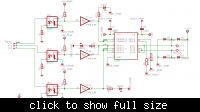dzakriel
Junior Member level 3

I need an IC buffer to keep the voltage from my micro high. When I program my micro to produce a high logic "1" (3.5-5v) I only get that much when i haven't connectt my micro to the device i need to control. because after i contact it to my device the voltage drop to the level 0.8-1.6V even i program it to produce 5V.
PLease give your advice, thank you.
PLease give your advice, thank you.


